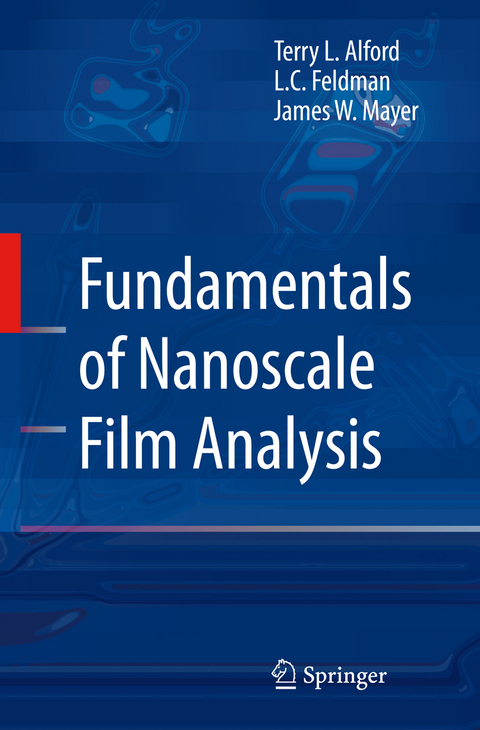Fundamentals of Nanoscale Film Analysis
Seiten
2007
|
2007 ed.
Springer-Verlag New York Inc.
978-0-387-29260-1 (ISBN)
Springer-Verlag New York Inc.
978-0-387-29260-1 (ISBN)
It describes characterization techniques to quantify the structure, composition and depth distribution of materials with the use of energetic particles and photons.The book describes the fundamentals of materials characterization from the standpoint of the incident photons or particles which interrogate nanoscale structures.
Modern science and technology, from materials science to integrated circuit development, is directed toward the nanoscale. From thin films to field effect transistors, the emphasis is on reducing dimensions from the micro to the nanoscale. Fundamentals of Nanoscale Film Analysis concentrates on analysis of the structure and composition of the surface and the outer few tens to hundred nanometers in depth. It describes characterization techniques to quantify the structure, composition and depth distribution of materials with the use of energetic particles and photons.
The book describes the fundamentals of materials characterization from the standpoint of the incident photons or particles which interrogate nanoscale structures. These induced reactions lead to the emission of a variety of detected of particles and photons. It is the energy and intensity of the detected beams that is the basis of the characterization of the materials. The array of experimental techniques used in nanoscale materials analysis covers a wide range of incident particle and detected beam interactions.
Included are such important interactions as atomic collisions, Rutherford backscattering, ion channeling, diffraction, photon absorption, radiative and nonradiative transitions, and nuclear reactions. A variety of analytical and scanning probe microscopy techniques are presented in detail.
Modern science and technology, from materials science to integrated circuit development, is directed toward the nanoscale. From thin films to field effect transistors, the emphasis is on reducing dimensions from the micro to the nanoscale. Fundamentals of Nanoscale Film Analysis concentrates on analysis of the structure and composition of the surface and the outer few tens to hundred nanometers in depth. It describes characterization techniques to quantify the structure, composition and depth distribution of materials with the use of energetic particles and photons.
The book describes the fundamentals of materials characterization from the standpoint of the incident photons or particles which interrogate nanoscale structures. These induced reactions lead to the emission of a variety of detected of particles and photons. It is the energy and intensity of the detected beams that is the basis of the characterization of the materials. The array of experimental techniques used in nanoscale materials analysis covers a wide range of incident particle and detected beam interactions.
Included are such important interactions as atomic collisions, Rutherford backscattering, ion channeling, diffraction, photon absorption, radiative and nonradiative transitions, and nuclear reactions. A variety of analytical and scanning probe microscopy techniques are presented in detail.
An Overview: Concepts, Units, and the Bohr Atom.- Atomic Collisions and Backscattering Spectrometry.- Energy Loss of Light Ions and Backscattering Depth Profiles.- Sputter Depth Profiles and Secondary Ion Mass Spectroscopy.- Ion Channeling.- Electron-Electron Interactions and the Depth Sensitivity of Electron Spectroscopies.- X-ray Diffraction.- Electron Diffraction.- Photon Absorption in Solids and EXAFS.- X-ray Photoelectron Spectroscopy.- Radiative Transitions and the Electron Microprobe.- Nonradiative Transitions and Auger Electron Spectroscopy.- Nuclear Techniques: Activation Analysis and Prompt Radiation Analysis.- Scanning Probe Microscopy.
| Zusatzinfo | XIV, 336 p. |
|---|---|
| Verlagsort | New York, NY |
| Sprache | englisch |
| Maße | 156 x 235 mm |
| Themenwelt | Naturwissenschaften ► Chemie ► Analytische Chemie |
| Naturwissenschaften ► Chemie ► Physikalische Chemie | |
| Technik ► Maschinenbau | |
| ISBN-10 | 0-387-29260-8 / 0387292608 |
| ISBN-13 | 978-0-387-29260-1 / 9780387292601 |
| Zustand | Neuware |
| Informationen gemäß Produktsicherheitsverordnung (GPSR) | |
| Haben Sie eine Frage zum Produkt? |
Mehr entdecken
aus dem Bereich
aus dem Bereich




